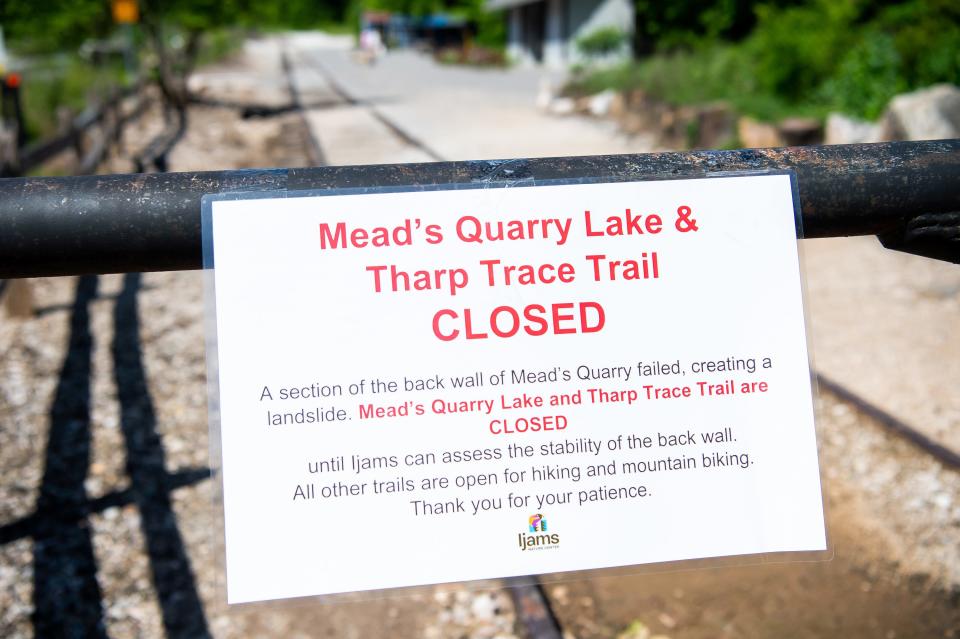A large landslide at Mead’s Quarry that sent tons of rock into the South Knoxville lake and pummeled swimmers with a wall of water over the weekend likely was caused by multiple factors, including several small earthquakes.
Ijams Nature Center closed Mead’s Quarry and Tharp Trace Trail while it works to bring geologists and engineers to the site to assess whether a similar event is likely to happen again. About five people were hurt, mostly with cuts and scrapes as they escaped the huge waves that crashed across the lake after the rocks hit the water. One person was hospitalized.
Ijams has invited experts from the University of Tennessee at Knoxville and the U.S. Geological Survey to examine the back wall, whose face is newly jagged since the May 25 slide. No scientists or engineers had assessed the quarry as of May 28, said Ijams President and CEO Amber Parker.
If experts are available this week, Ijams hopes to reopen the popular summer swimming and paddleboarding spot this weekend, Parker said. The desire to reopen is high, especially because neighboring Augusta Quarry is closed for renovations.
“We’re going to increase warnings just to make sure they understand,” Parker told Knox News. “We’re going to ask people to please be responsible. Listen to the signs. Do what the signs say. We want people to have a fun time.”
While an abnormally rainy May is good news for summer water sports, it might have helped turn Mead’s Quarry from a tranquil swimming hole into a frightening tsunami zone in a matter of seconds.
“Almost every landslide has multiple causes,” according to the U.S. Geological Survey, and the same appears to be true at Mead’s Quarry. Just hours before the rockslide – which happened shortly before 6 p.m. – the Knoxville region experienced a 2.4 magnitude earthquake and received an inch of rain.
A video posted to social media shows the dramatic moment the rock face fell and a wave struck the opposite shore, sucking belongings and people out into the water before pushing them back up.
Ijams warns swimmers to stay away from wall
Landslides are common at quarries, but this rock fall was one of the largest Parker has seen. Many boulders at the 318-acre nature center have fallen in past landslides, including some in the Primal Playground and one along the Pink Marble Trail nearby.
While Mead’s Quarry once produced Tennessee pink marble, the rock is actually a type of limestone. Limestone is one of several rocks that form karst landscapes, which erode with weather and water to form caves, sinkholes and springs. The wall at Mead’s Quarry might have been weakened long ago.
“Quarry stone is constantly falling off anyway because it has been hit by hundreds of tons of dynamite over the course of decades,” Parker said. “It is not the most stable thing, which is why we have always had that area demarcated with buoys.”
The Williams Limestone Company abandoned operations at Mead’s Quarry in the late 1970s, and it became a dangerous dumping ground for decades. Knox County purchased the quarry in 2001 and Ijams opened it as a family-friendly destination in 2005.
Ijams might expand the area cordoned off with buoys and add signs warning swimmers away from the wall. Before the rock face fell May 25, several large stones slapped the water.
Region sustained earthquakes before rockslide
Some of the possible forces behind the rockslide were invisible, playing out quietly below the Earth’s surface. Tennessee gets hundreds of earthquakes a year and most are too small to feel.
Know Your Knox: Earthquakes in Knoxville? How often they occur in East Tennessee and why
In the week leading up to the rockslide, the Knoxville region and surrounding areas sustained three minor earthquakes, according to USGS:
-
May 19: A 2.0 magnitude quake near Vonore
-
May 22: A 1.8 magnitude quake near Maryville
-
May 25: A 2.4 magnitude quake near Blaine
Farther north, a 2.7 magnitude quake hit near Hyden, Kentucky, on May 22.
Another factor that commonly leads to landslides is heavy rainfall. The Knoxville region has gotten over 8.5 inches of rain this month as of May 27. One full inch fell the day of the rockslide.
The average rainfall in Knoxville for May is just 3.6 inches, according to the National Weather Service.

Fallen rock to stay in quarry
There is no cleanup that must be done before the quarry reopens, Parker said. The tons of rock that fell will stay in the lake, which is between 75 and 100 feet deep. The remnants of the slide will join a few cars and some industrial debris at the bottom of the lake.
“It can accept a whole lot of rock and there’s no possible way for us to be able to get that out,” Parker said. “It would be a monumental task and one that’s not worth it. It’s not affecting anyone and in itself, it’s not a hazard because it’s so far down.”
Safety remains the top priority for Ijams, Parker said. In March, the center warned visitors not to swim in the lake or ingest its water during a bloom of potentially toxic pink algae, which lasted about a month.
Before firefighters and the Knox County Rescue Squad arrived at the scene of the rockslide, two River Sports Outfitters employees responded on boats to make sure visitors were safe. The local outdoor gear store rents boats and tubes to swimmers at Mead’s Quarry.
Ed McAlister, founder and president of River Sports, arrived at the “pretty hectic” scene around 15 minutes after the rockslide. He saw some scraped-up swimmers surrounded by first responders and heard about the frightening event from his staff, who were both composed and worried.
“The way they did respond and the professionalism they exhibited was a great feeling,” McAlister told Knox News. “I’m proud of them.”
Knoxville’s other quarry still closed
In the long run, Ijams plans to add new multipurpose buildings, an outdoor classroom, an accessible trail and better parking to the quarry as part of an ambitious master plan unveiled earlier this year. The upgrades will be funded in part by a $5 parking fee.
The nonprofit has 620,000 annual visitors. In recent years, it has received less funding from the city and county, which made up only 9% of its budget in 2023. Ijams receives donations and sells memberships, which come with complimentary parking.
Closing Mead’s Quarry at the beginning of summer, even temporarily, means Knoxville has no quarry lakes open for swimmers. The deeper and more dangerous sister of Mead’s Quarry, Augusta Quarry at Fort Dickerson Park, is closed while the city completes $3.6 million of upgrades.
Those renovations will add the Augusta Quarry’s first restrooms, an overlook, a renovated pedestrian pathway, and new floating beach and swim platforms. The city is on pace to complete the upgrades and reopen by late fall, Urban Wilderness Coordinator Wes Soward said in a May 23 release.
During the first phase of Augusta Quarry upgrades in 2023, the city spent $1.77 million on a new entrance and accessibility upgrades. In total, the city’s partnership with the Aslan Foundation will cost $5.4 million.
Daniel Dassow is a growth and development reporter focused on technology and energy. Phone 423-637-0878. Email daniel.dassow@knoxnews.com.
Support strong local journalism by subscribing at knoxnews.com/subscribe.
This article originally appeared on Knoxville News Sentinel: What caused Mead’s Quarry rockslide closing Ijams Nature Center lake?
Signup bonus from




